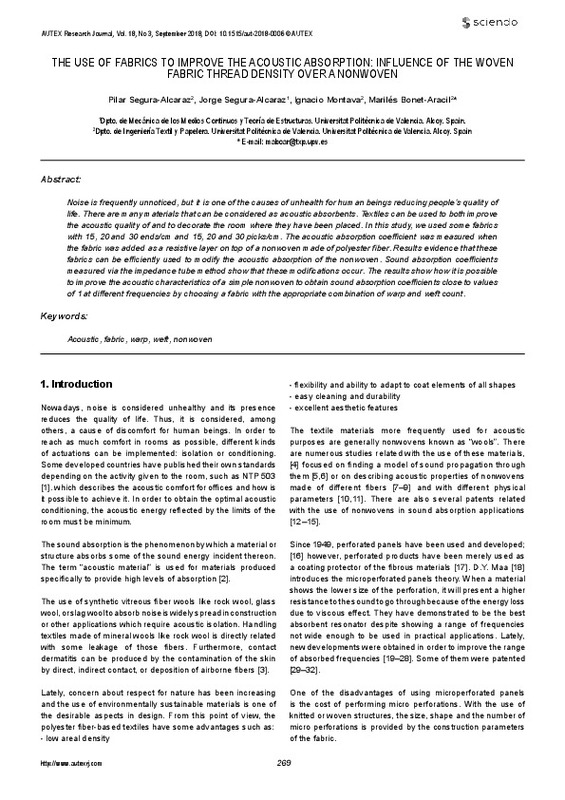JavaScript is disabled for your browser. Some features of this site may not work without it.
Buscar en RiuNet
Listar
Mi cuenta
Estadísticas
Ayuda RiuNet
Admin. UPV
The Use of Fabrics to Improve the Acoustic Absorption: Influence of the Woven Fabric Thread Density Over a Nonwoven
Mostrar el registro sencillo del ítem
Ficheros en el ítem
| dc.contributor.author | Segura-Alcaraz, María Del Pilar
|
es_ES |
| dc.contributor.author | Segura Alcaraz, Jorge Gabriel
|
es_ES |
| dc.contributor.author | Montava-Seguí, Ignacio
|
es_ES |
| dc.contributor.author | Bonet-Aracil, Marilés
|
|
| dc.date.accessioned | 2019-01-16T21:04:12Z | |
| dc.date.available | 2019-01-16T21:04:12Z | |
| dc.date.issued | 2018 | es_ES |
| dc.identifier.issn | 1470-9589 | es_ES |
| dc.identifier.uri | http://hdl.handle.net/10251/115611 | |
| dc.description.abstract | [EN] Noise is frequently unnoticed, but it is one of the causes of unhealth for human beings reducing people's quality of life. There are many materials that can be considered as acoustic absorbents. Textiles can be used to both improve the acoustic quality of and to decorate the room where they have been placed. In this study, we used some fabrics with 15, 20 and 30 ends/cm and 15, 20 and 30 picks/cm. The acoustic absorption coefficient was measured when the fabric was added as a resistive layer on top of a nonwoven made of polyester fiber. Results evidence that these fabrics can be efficiently used to modify the acoustic absorption of the nonwoven. Sound absorption coefficients measured via the impedance tube method show that these modifications occur. The results show how it is possible to improve the acoustic characteristics of a simple nonwoven to obtain sound absorption coefficients close to values of 1 at different frequencies by choosing a fabric with the appropriate combination of warp and weft count. | es_ES |
| dc.language | Inglés | es_ES |
| dc.publisher | Association of Universities for Textiles | es_ES |
| dc.relation.ispartof | AUTEX Research Journal | es_ES |
| dc.rights | Reconocimiento - No comercial - Sin obra derivada (by-nc-nd) | es_ES |
| dc.subject | Warp weft fabric | es_ES |
| dc.subject | Acoustic | es_ES |
| dc.subject | Nonwoven | es_ES |
| dc.subject.classification | MECANICA DE LOS MEDIOS CONTINUOS Y TEORIA DE ESTRUCTURAS | es_ES |
| dc.subject.classification | INGENIERIA TEXTIL Y PAPELERA | es_ES |
| dc.title | The Use of Fabrics to Improve the Acoustic Absorption: Influence of the Woven Fabric Thread Density Over a Nonwoven | es_ES |
| dc.type | Artículo | es_ES |
| dc.identifier.doi | 10.1515/aut-2018-0006 | es_ES |
| dc.rights.accessRights | Abierto | es_ES |
| dc.contributor.affiliation | Universitat Politècnica de València. Departamento de Ingeniería Textil y Papelera - Departament d'Enginyeria Tèxtil i Paperera | es_ES |
| dc.contributor.affiliation | Universitat Politècnica de València. Departamento de Mecánica de los Medios Continuos y Teoría de Estructuras - Departament de Mecànica dels Medis Continus i Teoria d'Estructures | es_ES |
| dc.description.bibliographicCitation | Segura-Alcaraz, MDP.; Segura Alcaraz, JG.; Montava-Seguí, I.; Bonet-Aracil, M. (2018). THE USE OF FABRICS TO IMPROVE THE ACOUSTIC ABSORPTION: INFLUENCE OF THE WOVEN FABRIC THREAD DENSITY OVER A NONWOVEN. AUTEX Research Journal. 18(3):269-280. doi:10.1515/aut-2018-0006 | es_ES |
| dc.description.accrualMethod | S | es_ES |
| dc.relation.publisherversion | https://doi.org/10.1515/aut-2018-0006 | es_ES |
| dc.description.upvformatpinicio | 269 | es_ES |
| dc.description.upvformatpfin | 280 | es_ES |
| dc.type.version | info:eu-repo/semantics/publishedVersion | es_ES |
| dc.description.volume | 18 | es_ES |
| dc.description.issue | 3 | es_ES |
| dc.relation.pasarela | S\375048 | es_ES |
| dc.description.references | Küçük, M., & Korkmaz, Y. (2012). The effect of physical parameters on sound absorption properties of natural fiber mixed nonwoven composites. Textile Research Journal, 82(20), 2043-2053. doi:10.1177/0040517512441987 | es_ES |
| dc.description.references | Pfretzschner, J., Cobo, P., Simón, F., Cuesta, M., & Fernández, A. (2006). Microperforated insertion units: An alternative strategy to design microperforated panels. Applied Acoustics, 67(1), 62-73. doi:10.1016/j.apacoust.2005.05.005 | es_ES |
| dc.description.references | Lundgren, L., Moberg, C., & Lidén, C. (2014). Do insulation products of man-made vitreous fibres still cause skin discomfort? Contact Dermatitis, 70(6), 351-360. doi:10.1111/cod.12178 | es_ES |
| dc.description.references | Garai, M., & Pompoli, F. (2005). A simple empirical model of polyester fibre materials for acoustical applications. Applied Acoustics, 66(12), 1383-1398. doi:10.1016/j.apacoust.2005.04.008 | es_ES |
| dc.description.references | Chevillotte, F. (2012). Controlling sound absorption by an upstream resistive layer. Applied Acoustics, 73(1), 56-60. doi:10.1016/j.apacoust.2011.07.005 | es_ES |
| dc.description.references | Dias, T., & Monaragala, R. (2006). Sound absorbtion in knitted structures for interior noise reduction in automobiles. Measurement Science and Technology, 17(9), 2499-2505. doi:10.1088/0957-0233/17/9/018 | es_ES |
| dc.description.references | Shoshani, Y. Z., & Wilding, M. A. (1991). Effect of Pile Parameters on the Noise Absorption Capacity of Tufted Carpets. Textile Research Journal, 61(12), 736-742. doi:10.1177/004051759106101207 | es_ES |
| dc.description.references | Delany, M. E., & Bazley, E. N. (1970). Acoustical properties of fibrous absorbent materials. Applied Acoustics, 3(2), 105-116. doi:10.1016/0003-682x(70)90031-9 | es_ES |
| dc.description.references | Shoshani, Y., & Rosenhouse, G. (1990). Noise absorption by woven fabrics. Applied Acoustics, 30(4), 321-333. doi:10.1016/0003-682x(90)90081-5 | es_ES |
| dc.description.references | Hanna, Y. I., & Kandil, M. M. (1991). Sound absorbing double curtains from local textile materials. Applied Acoustics, 34(4), 281-291. doi:10.1016/0003-682x(91)90011-3 | es_ES |








